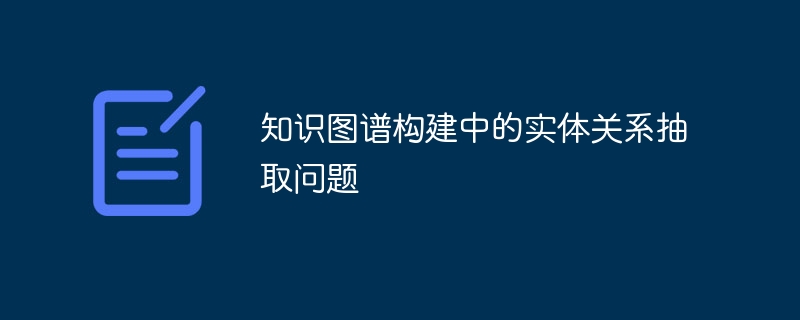

The problem of entity relationship extraction in knowledge graph construction requires specific code examples
With the development of information technology and the rapid popularization of the Internet, a large amount of text data has been Create and accumulate. These data contain a variety of information, but how to extract useful knowledge from these data becomes a challenge. The emergence of knowledge graph provides an effective way to solve this problem. Knowledge graph is a graph-based knowledge representation and reasoning model. By connecting entities in the form of nodes and using relationships as edges to represent the associations between entities, a structured knowledge network.
In the process of building a knowledge graph, entity relationship extraction is an important link. Entity relationship extraction aims to identify the relationships between entities from massive text data and convert them into structured data that can be understood and reasoned by computers. The core task of entity relationship extraction is to automatically identify and extract entities and their relationships from text.
In order to solve the problem of entity relationship extraction, researchers have proposed various methods and technologies. The following introduces an entity relationship extraction method based on machine learning.
First, you need to prepare the training data set. The training data set refers to a text data set that contains labeled entity and relationship information. It is usually necessary to manually label a part of the data set as the training set and test set of the model. The annotation method can be manual annotation or semi-automatic annotation.
Next, feature engineering is required. Feature engineering is the process of converting text data into feature vectors that can be processed by computers. Common features include Bag-of-Words, Word Embedding, and syntactic parsing trees. The purpose of feature engineering is to extract meaningful features that can represent entities and relationships for training models.
Then, select a suitable machine learning algorithm for model training. Common machine learning algorithms include support vector machine (Support Vector Machine), decision tree (Decision Tree), and deep learning algorithms. These algorithms can learn patterns and rules between entities and relationships through training data sets.
Finally, use the trained model to extract entity relationships from unlabeled text. Given a text sentence, feature engineering is first used to convert it into a feature vector, and then the trained model is used to predict and obtain the results of entities and relationships.
The following is a simple Python code example, using the support vector machine algorithm for entity relationship extraction:
# 导入相应的库 from sklearn.svm import SVC from sklearn.feature_extraction.text import TfidfVectorizer # 准备训练数据集 texts = ['人民', '共和国', '中华人民共和国', '中华', '国'] labels = ['人民与共和国', '中华人民共和国', '中华人民共和国', '中华与国', '中华人民共和国'] # 特征工程,使用TfidfVectorizer提取特征 vectorizer = TfidfVectorizer() features = vectorizer.fit_transform(texts) # 训练模型 model = SVC() model.fit(features, labels) # 预测 test_text = '中华共和国' test_feature = vectorizer.transform([test_text]) predicted = model.predict(test_feature) print(predicted)
In the above code example, we first prepared a set of training data sets, which contains Textual information about some entities and relationships. Then use TfidfVectorizer to extract features from the text and obtain the feature vector. Then the support vector machine algorithm is used for model training, and finally the unlabeled text is extracted and predicted for entity relationships.
In summary, the problem of entity relationship extraction in knowledge graph construction is an important research direction, and this problem can be effectively solved through machine learning methods. However, there are still some challenges in entity relationship extraction, such as semantic ambiguity, contextual information, etc. In the future, with the continuous development and innovation of technology, I believe this problem will be better solved. At the same time, we also need to pay attention to following related issues such as data privacy and knowledge ethics in practice to ensure the legitimacy and credibility of the knowledge graph construction.
The above is the detailed content of Entity relationship extraction problem in knowledge graph construction. For more information, please follow other related articles on the PHP Chinese website!




